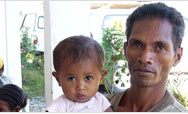You are here » Home » Telling Our Story
Case Study
Villagers regain incomes while sustaining fish resources
Replenishing Fish Stock and Cash Flow

| |
Photo: USAID/Saengroaj Srisawaskraisorn
|
|
Villagers from Kampuan, in Suk Samran district, train in fish breeding.
“I lost my boats and income after the tsunami. My life was brought down to zero. This project has given me a new chance to live on my own again,” said one villager from Suk Samran district.
|
Challenge
The December 2004 tsunami destroyed one of the major industries along Thailand’s Andaman Coast — fish farms. Fish stock suppliers had yet to rebuild and recover their capacity to replenish the small catfish farms many people ran. This left fisher families, who on average earned 30 percent of their household income from catfish farming, without resources to rebuild their lives.
Initiative
In response to this need, USAID brought nine village representatives from the village clusters of Kampuan, located in Thailand’s Ranong province, to Bangkok to learn how to produce young fish using artificial breeding techniques. During the training, villagers not only learned how to establish and manage backyard hatcheries but also developed simple business plans to foster future enterprise development.
Results
Villagers are now able to produce their own fish seed without having to rely on local suppliers. USAID provided communities with seed money to help villagers build backyard hatcheries and sell fish in the local market. Villagers develop a business plan and apply for a modest grant from the community. In order to expand small businesses and sustain fish resources in the local area, the villagers trained through USAID share their newly acquired knowledge of fish breeding with their neighbors. By diversifying fishery practices, villagers are becoming more resilient to economic and environmental factors that impact their lives and livelihoods.
Print-friendly version of this page (536kb - PDF)
Click here for high-res photo
Back to Top ^ | 

